從數據到決策:數據分析與機器學習如何推動業務成長
In this article, we explore and analyze a sales dataset to gain valuable insights and drive business growth. We have undertaken various steps, from data preprocessing to machine learning model training, to extract meaningful information and make informed decisions. Through this documentation, we aim to present our findings, methodologies, and recommendations to enhance sales performance, identify key customer segments, and optimize marketing strategies.
Dataset Overview
In this dataset, we have the following features:
- ORDER_ID: Unique identifier for each order.
- CUSTOMER_ID: Identifier for the customer who made the order.
- PRODUCT_ID: Identifier for the product in the order.
- ORDER_DATE: Date the order was made.
- QUANTITY: Quantity of the product in the order.
- UNIT_PRICE: Unit price of the product in the order.
- TOTAL_SALES: Total sales for this order (calculated as QUANTITY * UNIT_PRICE).
- CUSTOMER_FEATURE_1, CUSTOMER_FEATURE_2: Synthetic features representing customer properties.
- PRODUCT_FEATURE_1, PRODUCT_FEATURE_2: Synthetic features representing product properties.

What You'll Learn
In this article, we guide you through:
. Data Cleaning and Preprocessing: How we cleaned the dataset and handled missing values, with an explanation of the chosen methods.
. Exploratory Data Analysis: Insights on sales distribution, relationships between features, and the identification of patterns or anomalies.
. Model Development and Evaluation: Training a machine learning model to forecast TOTAL_SALES, evaluating its performance with relevant metrics.
. Business Insights: Key findings to enhance sales performance, optimize marketing strategies, and identify top-performing product categories and customer segments.
Let's dive into the analysis and discover how these insights can drive business growth.
. Data Cleaning and Preprocessing
1. A Deep Dive into Dataset: Detecting Null Values
To ensure the accuracy of our analysis, we began by thoroughly examining the dataset to identify columns with missing or null values. We counted the number of null values in each column to assess the extent of missing data. This step is crucial as missing values can significantly impact the quality of our analysis.
2. Categorizing Data: Identifying Categorical Columns
Next, we identified the categorical columns within our dataset. These columns typically contain discrete values representing different categories or labels. By evaluating the number of unique values in each categorical column, we gained insights into the diversity of categories present, which helps us understand potential grouping patterns and relationships within the data.
3. Dataset Overview and Handling Missing Data
We utilized the describe() function to obtain a concise summary of the dataset's numerical columns. This function provides essential statistical properties, including count, mean, standard deviation, quartiles, minimum, and maximum values. Our histogram and box plot analyses revealed that the numerical columns did not exhibit significant skewness. Therefore, to handle missing values, we opted to replace them with the mean value of each respective column. This approach helps maintain data integrity for subsequent analysis.
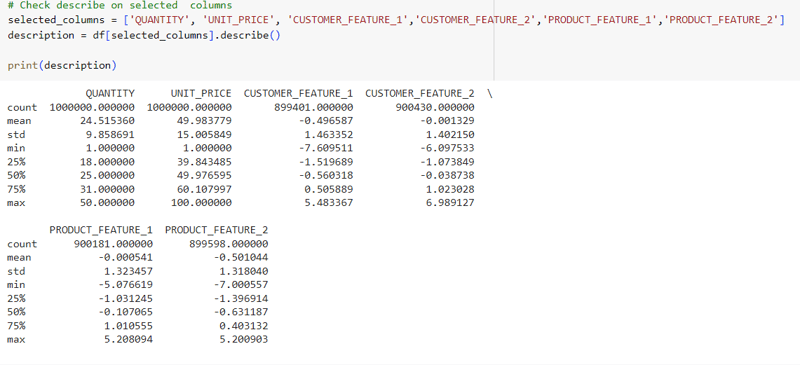
4. Converting Categorical Columns: Creating Numerical Representations
To prepare the categorical data for machine learning algorithms, we employed techniques such as one-hot encoding and the get_dummies() function. These methods convert categorical columns into numerical formats by creating binary variables, allowing algorithms to effectively process and analyze the data.

5. Feature Selection: Removing Unnecessary Columns
Finally, we examined the 'ORDER_DATE' and 'ORDER_ID' columns. Since these columns contain unique values for each row, they do not provide meaningful patterns or relationships for machine learning models. Including them in the model would not contribute valuable information for predicting the target variable. Consequently, we decided to exclude these columns from the feature set used for ML modeling. We made a copy of the original dataframe before removing these columns. This copy will be utilized for visualization and analyzing feature relationships, while the modified dataframe, with the unnecessary columns dropped, will be used for model training to enhance prediction performance.
. Exploratory Data Analysis
In this section, we delve into an in-depth exploration of the dataset to understand the relationships between various features and sales. Our analysis focuses on customer segments, product categories, and seasonal trends to uncover insights that can enhance sales performance.
To reveal meaningful patterns, we employed various visualization techniques, including bar plots, line plots, and descriptive statistics. This exploration aimed to identify dominant customer segments, popular product categories, and variations in sales behavior over time.
Here are the key findings from our exploratory analysis:
1. Customer Segments Frequency
- The 'Y' customer segment emerged as the most frequent, followed by 'Z' and 'X.' Each segment differed by approximately 10,000 occurrences in orders.

2. Product Categories Frequency
- The 'B' product category had the highest frequency, with approximately 110,000 more occurrences than the other categories ('A,' 'C,' and 'D'), which were relatively close in frequency.
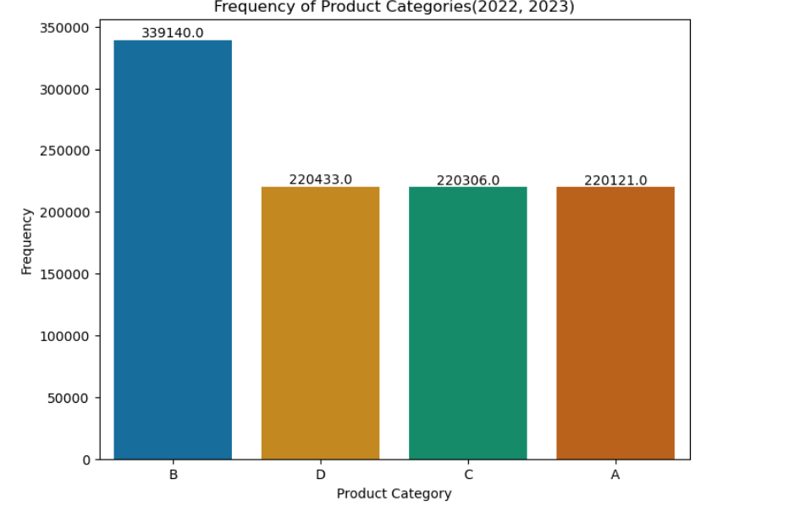
3. Product Category and Customer Segment Combination Frequency
- The combination of the 'Y' customer segment and 'B' product category was the most frequent.

4. Total Sales Amount for Each Product
- Product 78 recorded the highest total sales amount at 12,533,460, while product 21 had the lowest at 11,956,700. This indicates that total sales amounts are relatively close for different products.
5. Number of Products Ordered by Season and Year (Bar Plot)
- Orders were notably lower in winter compared to other seasons. Additionally, the number of orders for each season in 2022 and 2023 was similar, except for winter, where 2023 saw fewer orders than 2022.
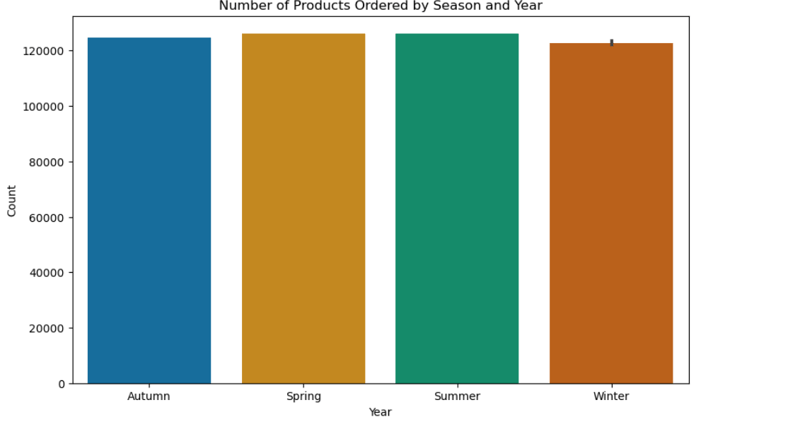
6. Number of Products Ordered by Season (Line Plot)
- A general decrease in product orders was observed during winter. The year 2023 showed a decline in orders compared to 2022, particularly in winter.
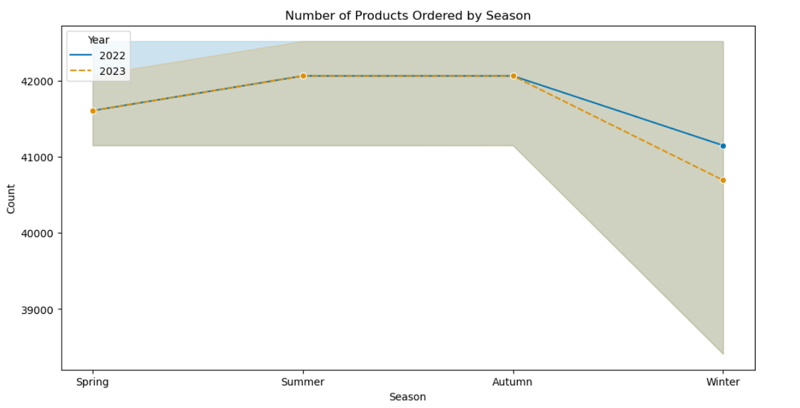
7. Number of Products Ordered by Month
- February recorded the lowest order rate. Orders were higher for odd months in the first half of the year and for even months in the second half, except for December 2023, which matched November 2023 in order volume.
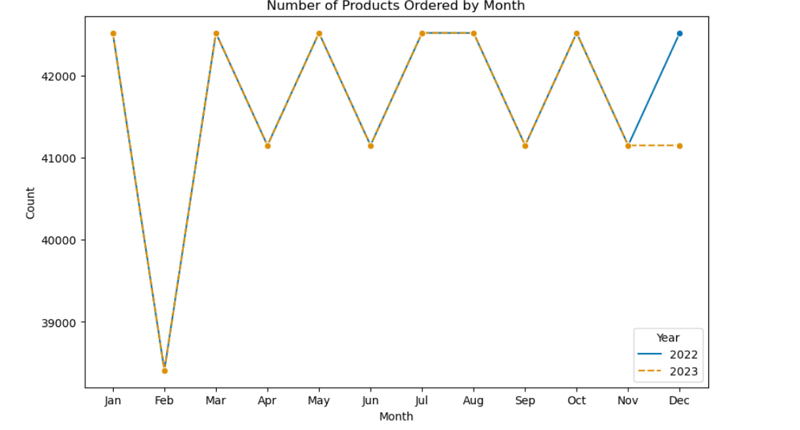
8. Total Sales Amount by Season
- Winter months in both 2022 and 2023 experienced lower total sales compared to other seasons. Additionally, total sales in winter 2023 were slightly lower than in winter 2022.
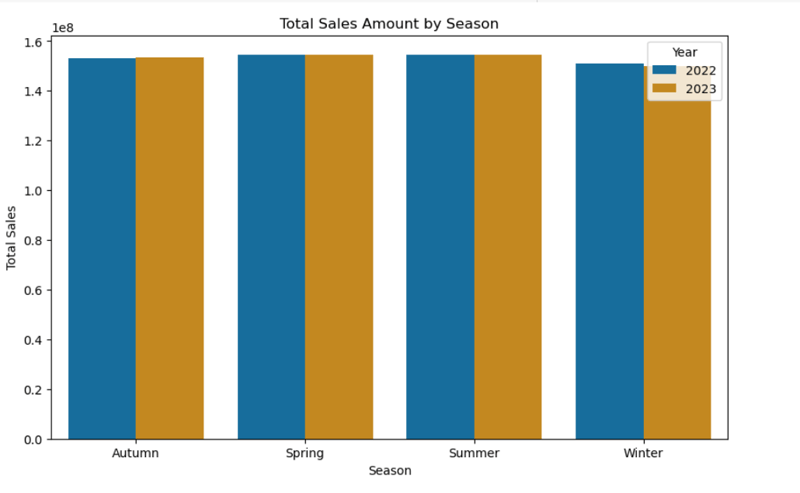
These exploratory analyses provide valuable insights into the dynamics of sales and customer behavior. By understanding these patterns, we can make informed decisions and develop strategies to optimize sales performance and drive revenue growth.
. Model Development and Evaluation
In this section, we detail the process of training and evaluating machine learning models to forecast total sales. The following steps outline our approach:
1. Data Preprocessing
We began by cleaning and preparing the dataset, handling missing values, and encoding categorical variables. This preparation was crucial for ensuring the dataset was suitable for modeling.
- Splitting the Data: We divided the preprocessed data into training and testing sets, allocating 70% for training and 30% for testing. This split helps us evaluate the model's performance on unseen data, ensuring a reliable assessment of its ability to generalize.
Although we initially aimed to use k-fold cross-validation for a more robust evaluation, memory limitations and the complexity of certain models like MLP, RBF, and XGBoost led us to use the train-test split method. Despite its simplicity, this method provides a viable alternative for assessing model performance.
2. Model Selection
We selected the following machine learning algorithms based on the complexity of the sales dataset and the nature of the problem:
MLP (Multi-Layer Perceptron): Suitable for capturing non-linear interactions and hidden patterns in the data, MLP can effectively handle the complexity of various customer segments, product categories, and seasonal patterns.
XGBoost: Known for its robustness against overfitting and ability to handle structured data, XGBoost helps identify feature importance and understand the factors affecting sales.
Random Forest: With its ensemble approach, Random Forest manages high-dimensional data well and reduces the risk of overfitting, offering stable predictions even with noisy data.
Gradient Boosting: By combining weak learners sequentially, Gradient Boosting captures complex feature relationships and improves model performance iteratively.
3. Training the Model
Each selected model was trained using the training dataset with the .fit() method.
4. Model Evaluation
We evaluated the trained models using several metrics:
Mean Squared Error (MSE): Measures the average of the squared differences between predicted and actual values. A lower MSE indicates better accuracy.
Mean Absolute Error (MAE): Calculates the average of the absolute differences between predicted and actual values, reflecting the average magnitude of errors. A lower MAE also indicates better performance.
R-squared Score: Represents the proportion of variance in the target variable (TOTAL_SALES) explained by the model. An R-squared score closer to 1 suggests a better fit.
Results Interpretation:
MLP (Multi-Layer Perceptron): Achieved very low MSE and MAE, with an R-squared score nearing 1, indicating excellent performance in predicting TOTAL_SALES.
XGBoost: Also performed well with relatively low MSE and MAE values and a high R-squared score, showing strong correlation between predicted and actual values.
Random Forest: Delivered the lowest MSE and MAE among all models and a high R-squared score, making it the most accurate for forecasting TOTAL_SALES.
Gradient Boosting: While it had higher MSE and MAE compared to other models, it still demonstrated a strong correlation between predictions and actual values with a high R-squared score.
In summary, the Random Forest model emerged as the best performer, with the lowest MSE and MAE and the highest R-squared score.

5. Hyperparameter Tuning
We performed hyperparameter tuning using techniques like grid search or random search to optimize the models' performance further.
6. Prediction
The trained models were used to make predictions on new data with the .predict() method.
7. Model Deployment
We deployed the best-performing model in a production environment to facilitate real-world use.
8. Model Monitoring and Maintenance
Continuous monitoring of the model’s performance is essential. We will update the model as needed to maintain accuracy over time.
9. Interpretation and Analysis
Finally, we analyzed the model’s results to gain actionable insights and make informed business decisions.
This comprehensive approach ensures that we develop robust, accurate models that can effectively forecast sales and support strategic decision-making.
. Business Insights
Our data analysis has uncovered several key insights that can drive sales growth and optimize business strategies:
1. Targeted Marketing
- The 'Y' customer segment demonstrated a higher purchase frequency compared to 'Z' and 'X.' To capitalize on this, we recommend implementing targeted marketing campaigns specifically designed for segment 'Y.' This approach can further engage this high-potential customer group and boost sales.
2. Product Promotion
- Product category 'B' showed the highest purchase frequency among all categories. Focusing promotional efforts on products within category 'B' can leverage its popularity and drive additional sales. Tailored marketing campaigns and special offers for this category can amplify its success.
3. Customer Rewards and Incentives
- Introducing a rewards program aimed at customer segments 'X' and 'Z' can encourage repeat purchases and build customer loyalty. Personalized discounts or incentives can motivate these segments to increase their purchase frequency and enhance overall sales.
4. Product Recommendations
- Utilizing data analytics to offer personalized product recommendations to customers in segment 'Y' and for products in category 'B' can significantly improve the shopping experience. Enhanced recommendations are likely to increase cross-selling opportunities and drive additional sales.
5. Improving Customer Experience
- Enhancing the overall customer experience—through exceptional customer support, intuitive interfaces, and seamless interactions—can positively influence all customer segments and product categories. A superior customer experience encourages conversions and fosters repeat business.
By leveraging these insights, we can tailor strategies to effectively target specific customer segments and product categories, optimizing sales performance and driving revenue growth. Continuous monitoring and adaptation based on ongoing data analysis will be crucial for maintaining success and achieving business objectives.
-
 如何使用FormData()處理多個文件上傳?)處理多個文件輸入時,通常需要處理多個文件上傳時,通常是必要的。 The fd.append("fileToUpload[]", files[x]); method can be used for this purpose, allowing you to send multi...程式設計 發佈於2025-07-08
如何使用FormData()處理多個文件上傳?)處理多個文件輸入時,通常需要處理多個文件上傳時,通常是必要的。 The fd.append("fileToUpload[]", files[x]); method can be used for this purpose, allowing you to send multi...程式設計 發佈於2025-07-08 -
 編譯器報錯“usr/bin/ld: cannot find -l”解決方法錯誤:“ usr/bin/ld:找不到-l “ 此錯誤表明鏈接器在鏈接您的可執行文件時無法找到指定的庫。為了解決此問題,我們將深入研究如何指定庫路徑並將鏈接引導到正確位置的詳細信息。 添加庫搜索路徑的一個可能的原因是,此錯誤是您的makefile中缺少庫搜索路徑。要解決它,您可以在鏈接器命令中添...程式設計 發佈於2025-07-08
編譯器報錯“usr/bin/ld: cannot find -l”解決方法錯誤:“ usr/bin/ld:找不到-l “ 此錯誤表明鏈接器在鏈接您的可執行文件時無法找到指定的庫。為了解決此問題,我們將深入研究如何指定庫路徑並將鏈接引導到正確位置的詳細信息。 添加庫搜索路徑的一個可能的原因是,此錯誤是您的makefile中缺少庫搜索路徑。要解決它,您可以在鏈接器命令中添...程式設計 發佈於2025-07-08 -
 如何從Python中的字符串中刪除表情符號:固定常見錯誤的初學者指南?從python import codecs import codecs import codecs 導入 text = codecs.decode('這狗\ u0001f602'.encode('utf-8'),'utf-8') 印刷(文字)#帶有...程式設計 發佈於2025-07-08
如何從Python中的字符串中刪除表情符號:固定常見錯誤的初學者指南?從python import codecs import codecs import codecs 導入 text = codecs.decode('這狗\ u0001f602'.encode('utf-8'),'utf-8') 印刷(文字)#帶有...程式設計 發佈於2025-07-08 -
 如何從PHP中的數組中提取隨機元素?從陣列中的隨機選擇,可以輕鬆從數組中獲取隨機項目。考慮以下數組:; 從此數組中檢索一個隨機項目,利用array_rand( array_rand()函數從數組返回一個隨機鍵。通過將$項目數組索引使用此鍵,我們可以從數組中訪問一個隨機元素。這種方法為選擇隨機項目提供了一種直接且可靠的方法。程式設計 發佈於2025-07-08
如何從PHP中的數組中提取隨機元素?從陣列中的隨機選擇,可以輕鬆從數組中獲取隨機項目。考慮以下數組:; 從此數組中檢索一個隨機項目,利用array_rand( array_rand()函數從數組返回一個隨機鍵。通過將$項目數組索引使用此鍵,我們可以從數組中訪問一個隨機元素。這種方法為選擇隨機項目提供了一種直接且可靠的方法。程式設計 發佈於2025-07-08 -
 `console.log`顯示修改後對象值異常的原因foo = [{id:1},{id:2},{id:3},{id:4},{id:id:5},],]; console.log('foo1',foo,foo.length); foo.splice(2,1); console.log('foo2', foo, foo....程式設計 發佈於2025-07-08
`console.log`顯示修改後對象值異常的原因foo = [{id:1},{id:2},{id:3},{id:4},{id:id:5},],]; console.log('foo1',foo,foo.length); foo.splice(2,1); console.log('foo2', foo, foo....程式設計 發佈於2025-07-08 -
 FastAPI自定義404頁面創建指南response = await call_next(request) if response.status_code == 404: return RedirectResponse("https://fastapi.tiangolo.com") else: ...程式設計 發佈於2025-07-08
FastAPI自定義404頁面創建指南response = await call_next(request) if response.status_code == 404: return RedirectResponse("https://fastapi.tiangolo.com") else: ...程式設計 發佈於2025-07-08 -
 C++20 Consteval函數中模板參數能否依賴於函數參數?[ consteval函數和模板參數依賴於函數參數在C 17中,模板參數不能依賴一個函數參數,因為編譯器仍然需要對非contexexpr futcoriations contim at contexpr function進行評估。 compile time。 C 20引入恆定函數,必須在編譯時進...程式設計 發佈於2025-07-08
C++20 Consteval函數中模板參數能否依賴於函數參數?[ consteval函數和模板參數依賴於函數參數在C 17中,模板參數不能依賴一個函數參數,因為編譯器仍然需要對非contexexpr futcoriations contim at contexpr function進行評估。 compile time。 C 20引入恆定函數,必須在編譯時進...程式設計 發佈於2025-07-08 -
 如何將MySQL數據庫添加到Visual Studio 2012中的數據源對話框中?在Visual Studio 2012 儘管已安裝了MySQL Connector v.6.5.4,但無法將MySQL數據庫添加到實體框架的“ DataSource對話框”中。為了解決這一問題,至關重要的是要了解MySQL連接器v.6.5.5及以後的6.6.x版本將提供MySQL的官方Visual...程式設計 發佈於2025-07-08
如何將MySQL數據庫添加到Visual Studio 2012中的數據源對話框中?在Visual Studio 2012 儘管已安裝了MySQL Connector v.6.5.4,但無法將MySQL數據庫添加到實體框架的“ DataSource對話框”中。為了解決這一問題,至關重要的是要了解MySQL連接器v.6.5.5及以後的6.6.x版本將提供MySQL的官方Visual...程式設計 發佈於2025-07-08 -
 Java的Map.Entry和SimpleEntry如何簡化鍵值對管理?A Comprehensive Collection for Value Pairs: Introducing Java's Map.Entry and SimpleEntryIn Java, when defining a collection where each element com...程式設計 發佈於2025-07-08
Java的Map.Entry和SimpleEntry如何簡化鍵值對管理?A Comprehensive Collection for Value Pairs: Introducing Java's Map.Entry and SimpleEntryIn Java, when defining a collection where each element com...程式設計 發佈於2025-07-08 -
 如何使用PHP將斑點(圖像)正確插入MySQL?essue VALUES('$this->image_id','file_get_contents($tmp_image)')";This code builds a string in PHP, but the function call fil...程式設計 發佈於2025-07-08
如何使用PHP將斑點(圖像)正確插入MySQL?essue VALUES('$this->image_id','file_get_contents($tmp_image)')";This code builds a string in PHP, but the function call fil...程式設計 發佈於2025-07-08 -
 如何使用Depimal.parse()中的指數表示法中的數字?在嘗試使用Decimal.parse(“ 1.2345e-02”中的指數符號表示法表示的字符串時,您可能會遇到錯誤。這是因為默認解析方法無法識別指數符號。 成功解析這樣的字符串,您需要明確指定它代表浮點數。您可以使用numbersTyles.Float樣式進行此操作,如下所示:[&& && && ...程式設計 發佈於2025-07-08
如何使用Depimal.parse()中的指數表示法中的數字?在嘗試使用Decimal.parse(“ 1.2345e-02”中的指數符號表示法表示的字符串時,您可能會遇到錯誤。這是因為默認解析方法無法識別指數符號。 成功解析這樣的字符串,您需要明確指定它代表浮點數。您可以使用numbersTyles.Float樣式進行此操作,如下所示:[&& && && ...程式設計 發佈於2025-07-08 -
 如何將PANDAS DataFrame列轉換為DateTime格式並按日期過濾?Transform Pandas DataFrame Column to DateTime FormatScenario:Data within a Pandas DataFrame often exists in various formats, including strings.使用時間數據時...程式設計 發佈於2025-07-08
如何將PANDAS DataFrame列轉換為DateTime格式並按日期過濾?Transform Pandas DataFrame Column to DateTime FormatScenario:Data within a Pandas DataFrame often exists in various formats, including strings.使用時間數據時...程式設計 發佈於2025-07-08 -
 將圖片浮動到底部右側並環繞文字的技巧在Web設計中圍繞在Web設計中,有時可以將圖像浮動到頁面右下角,從而使文本圍繞它纏繞。這可以在有效地展示圖像的同時創建一個吸引人的視覺效果。 css位置在右下角,使用css float and clear properties: img { 浮點:對; ...程式設計 發佈於2025-07-08
將圖片浮動到底部右側並環繞文字的技巧在Web設計中圍繞在Web設計中,有時可以將圖像浮動到頁面右下角,從而使文本圍繞它纏繞。這可以在有效地展示圖像的同時創建一個吸引人的視覺效果。 css位置在右下角,使用css float and clear properties: img { 浮點:對; ...程式設計 發佈於2025-07-08 -
 如何使用“ JSON”軟件包解析JSON陣列?parsing JSON與JSON軟件包 QUALDALS:考慮以下go代碼:字符串 } func main(){ datajson:=`[“ 1”,“ 2”,“ 3”]`` arr:= jsontype {} 摘要:= = json.unmarshal([] byte(...程式設計 發佈於2025-07-08
如何使用“ JSON”軟件包解析JSON陣列?parsing JSON與JSON軟件包 QUALDALS:考慮以下go代碼:字符串 } func main(){ datajson:=`[“ 1”,“ 2”,“ 3”]`` arr:= jsontype {} 摘要:= = json.unmarshal([] byte(...程式設計 發佈於2025-07-08
學習中文
- 1 走路用中文怎麼說? 走路中文發音,走路中文學習
- 2 坐飛機用中文怎麼說? 坐飞机中文發音,坐飞机中文學習
- 3 坐火車用中文怎麼說? 坐火车中文發音,坐火车中文學習
- 4 坐車用中文怎麼說? 坐车中文發音,坐车中文學習
- 5 開車用中文怎麼說? 开车中文發音,开车中文學習
- 6 游泳用中文怎麼說? 游泳中文發音,游泳中文學習
- 7 騎自行車用中文怎麼說? 骑自行车中文發音,骑自行车中文學習
- 8 你好用中文怎麼說? 你好中文發音,你好中文學習
- 9 謝謝用中文怎麼說? 谢谢中文發音,谢谢中文學習
- 10 How to say goodbye in Chinese? 再见Chinese pronunciation, 再见Chinese learning

























